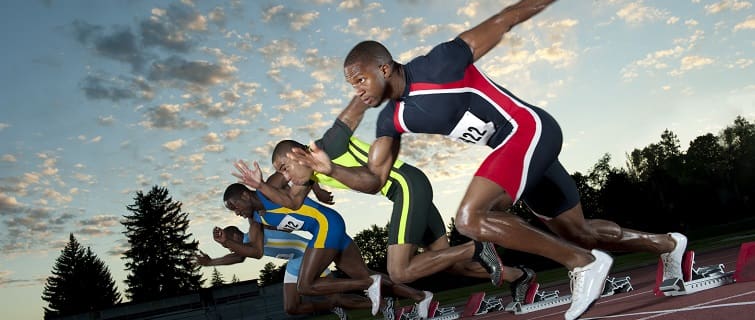Sports
8 Key Performance Enhancement Strategies Every Athlete Needs to Know


Understanding the intricacies of performance enhancement is a critical aspect of an athlete’s journey towards excellence. In a world where the margin between victory and defeat is often razor-thin, it becomes imperative for athletes to leverage every possible advantage in their pursuit of success.
The 8 key performance enhancement strategies we are about to explore have been honed and refined through years of research and application, offering a holistic approach that encompasses both the physical and mental dimensions of athletic performance. These strategies have the potential to not only elevate an athlete’s capabilities but also redefine the boundaries of what is achievable in their chosen discipline.
Key Takeaways
- Mental imagery and visualization techniques enhance skills, confidence, and focus in athletes.
- Routine development and focus techniques provide structure, clarity, and resilience for consistent performance.
- Breathing and relaxation techniques help manage stress, improve concentration, and maintain presence in the moment.
- Positive reinforcement, self-assessment, and goal setting empower athletes to improve performance and achieve success.
Mental Imagery
Mental imagery, often referred to as visualization, is a cognitive technique used by athletes to mentally rehearse and simulate athletic performance in order to enhance skill acquisition, performance, and overall psychological well-being.
This powerful tool involves creating a mental image or scenario of the desired athletic performance, engaging all the senses to make the experience as vivid and real as possible.
Research has shown that mental imagery can improve physical performance by strengthening neural pathways related to the skill being imagined.


Athletes can use mental imagery to visualize themselves executing flawless movements, overcoming obstacles, and achieving success in their sport.
By repeatedly visualizing successful performances, athletes can increase their confidence, reduce anxiety, and enhance their focus during actual competitions.
Additionally, mental imagery can be used to practice coping strategies for managing pressure, setbacks, and pain, thus promoting psychological resilience and well-being.
When utilized effectively, mental imagery can serve as a valuable tool for athletes seeking to optimize their performance and achieve their full potential.
Routine Development
To enhance athletic performance, athletes can develop a structured routine that encompasses physical training, mental preparation, and recovery strategies. A well-designed routine not only sets the foundation for consistent performance but also provides a sense of freedom and autonomy in the athlete’s pursuit of excellence.


Here are three key components to consider when developing a performance-enhancing routine:
- Goal Setting: Establishing clear and achievable short-term and long-term goals can ignite a sense of purpose and motivation, empowering athletes to push their limits and overcome obstacles with freedom and determination.
- Mindfulness Practices: Integrating mindfulness techniques such as meditation, deep breathing exercises, or visualization can foster mental clarity, emotional resilience, and a sense of liberation from distractions, ultimately enhancing overall performance.
- Rest and Recovery: Prioritizing adequate rest, sleep, and recovery activities not only facilitates physical recuperation but also grants athletes the freedom to fully engage in training and competition with renewed energy and vigor.
Concentration Techniques
Concentration techniques are essential for athletes to maintain focus and block out distractions during training and competition.
Mental imagery practice allows athletes to visualize their performance, enhancing their ability to execute skills effectively.
Additionally, incorporating breathing and relaxation techniques can help athletes manage stress and anxiety, ultimately improving their concentration and overall performance.
Focus and Block Distractions
Focused attention is a crucial component of athletic performance, and mastering techniques to block distractions can significantly enhance an athlete’s ability to maintain concentration during training and competition.


To achieve this, athletes can employ the following strategies:
- Visualization: Use mental imagery to create a focused and distraction-free mindset, visualizing successful performance in the face of potential distractions.
- Mindfulness: Practice mindfulness techniques to stay present in the moment, letting go of external distractions and maintaining a clear focus on the task at hand.
- Controlled breathing: Employ controlled breathing exercises to calm the mind and maintain concentration, allowing athletes to block out disruptive external stimuli and stay in the zone.
Mental Imagery Practice
Implementing mental imagery practice can significantly enhance an athlete’s concentration and performance by reinforcing neural pathways associated with successful execution of skills and routines. When engaging in mental imagery practice, athletes create vivid and detailed mental images of themselves performing at their best.
This technique allows athletes to rehearse their movements, strategies, and game plans, leading to improved focus and a heightened sense of confidence. Research has shown that mental imagery practice can activate the same neural pathways as physical practice, leading to improved muscle memory and skill retention.
Athletes can use mental imagery practice to visualize overcoming challenges, staying calm under pressure, and achieving their goals. By incorporating mental imagery practice into their training regimen, athletes can develop a powerful tool for enhancing concentration and overall performance on the field, court, or track.
Breathing and Relaxation
Breathing and relaxation techniques are essential components of an athlete’s training regimen, offering valuable tools for enhancing focus and optimizing performance on the field, court, or track.


When it comes to concentration techniques, athletes can benefit from:
- Diaphragmatic breathing: By focusing on deep, slow breaths that engage the diaphragm, athletes can reduce stress and increase oxygen flow, promoting a state of calm and focus.
- Progressive muscle relaxation: This technique involves tensing and then relaxing different muscle groups, promoting physical and mental relaxation, which can be particularly helpful in high-pressure situations.
- Mindfulness meditation: Practicing mindfulness can help athletes develop a non-judgmental awareness of the present moment, allowing them to let go of distractions and perform with freedom and clarity.
These techniques can empower athletes to maximize their mental resilience and performance freedom.
Positive Reinforcement
Athletes can significantly benefit from the use of positive reinforcement techniques to enhance their performance and motivation. Positive reinforcement involves the use of rewards, encouragement, and constructive feedback to strengthen desired behaviors and boost confidence. Research has consistently shown that athletes who receive positive reinforcement are more likely to demonstrate increased effort, perseverance, and overall performance. By acknowledging and rewarding small improvements, athletes are more likely to stay motivated and engaged in their training programs. Coaches and trainers play a pivotal role in providing positive reinforcement, as their feedback and support can profoundly impact an athlete’s mindset and self-belief.
One effective strategy is to use specific and genuine praise to recognize the athlete’s efforts and achievements. This can help reinforce the desired behaviors and inspire them to continue striving for excellence. Additionally, setting attainable goals and celebrating milestones along the way can further reinforce positive behaviors and maintain motivation. Athletes should also be encouraged to engage in positive self-talk and visualization techniques to reinforce their confidence and mental resilience.
Arousal Regulation
To optimize athletic performance, effective arousal regulation techniques are essential for athletes to manage their physiological and psychological states during training and competition. Arousal regulation is crucial as it helps athletes find the optimal level of alertness and anxiety to maximize their performance.
Here are three evidence-based strategies for arousal regulation:
- Mindfulness and deep breathing exercises: Practicing mindfulness and deep breathing can help athletes stay present and calm, reducing excessive arousal levels and promoting a state of focused readiness.
- Imagery and mental rehearsal: Visualization techniques can help athletes mentally rehearse their performance, managing arousal levels by creating a sense of familiarity and confidence in high-pressure situations.
- Routine and pre-performance rituals: Establishing a consistent pre-performance routine can help athletes regulate arousal by providing a sense of control and familiarity, reducing anxiety and enhancing focus.
Mindfulness
Effective arousal regulation is closely linked to the practice of mindfulness, which can significantly benefit athletes in managing their physiological and psychological states during training and competition. Mindfulness involves the intentional focus on the present moment without judgment. For athletes, mindfulness can help in developing awareness of bodily sensations, thoughts, and emotions, thus enabling them to regulate their reactions to stressors and distractions. Research has shown that regular mindfulness practice can lead to improvements in attention control, emotional regulation, and stress management, all of which are crucial for optimizing athletic performance.
Athletes can incorporate mindfulness into their training routines through various techniques such as deep breathing exercises, body scans, and meditation. These practices can aid in enhancing self-awareness, promoting relaxation, and reducing anxiety, ultimately leading to better performance outcomes.
Moreover, mindfulness can also contribute to injury prevention by increasing body awareness and promoting better movement patterns.
Self-Assessment
Self-assessment is a critical component of an athlete’s performance enhancement strategy, as it involves identifying strengths and weaknesses to inform targeted improvement efforts.


By carefully evaluating their current abilities and areas for growth, athletes can set specific, measurable, achievable, relevant, and time-bound (SMART) performance goals.
This process allows athletes to develop tailored training plans that optimize their strengths and address their weaknesses, ultimately leading to enhanced performance outcomes.
Identifying Strengths and Weaknesses
Before embarking on a journey of performance enhancement, athletes must engage in a thorough and honest assessment of their strengths and weaknesses.
This self-assessment is crucial for understanding where improvements can be made and where existing skills can be leveraged.
Identifying strengths and weaknesses involves a combination of objective analysis and introspection. Athletes should consider seeking feedback from coaches, teammates, and trainers, as well as analyzing their performance data.


It’s important to approach this process with an open mind and a willingness to acknowledge areas that need improvement.
This self-awareness can be empowering and is the first step towards targeted and effective training.
- Acknowledge areas that need improvement
- Embrace existing strengths
- Seek feedback from others
Setting Performance Goals
In the pursuit of optimizing athletic performance, the process of setting performance goals through self-assessment is a critical and foundational step for athletes seeking targeted and evidence-based training strategies.
Self-assessment allows athletes to identify specific areas for improvement, leading to more effective and efficient training programs.
Athletes should begin by conducting a thorough evaluation of their current performance levels, considering factors such as strength, endurance, speed, and skill proficiency.


By setting specific, measurable, achievable, relevant, and time-bound (SMART) goals, athletes can create a roadmap for their athletic development. This involves breaking down long-term objectives into smaller, manageable targets.
Regular reassessment of these goals is crucial, as it enables athletes to track their progress, make necessary adjustments, and stay motivated.
Ultimately, setting performance goals through self-assessment empowers athletes to take ownership of their training and achieve greater success in their athletic endeavors.
Cognitive Restructuring
One effective cognitive restructuring strategy for athletes involves systematically challenging and modifying maladaptive thought patterns to enhance performance. This technique is grounded in the understanding that our thoughts influence our emotions, behaviors, and ultimately our performance. By identifying and changing negative thought patterns, athletes can improve their focus, confidence, and overall mental resilience.
Here are three key components of cognitive restructuring that can evoke an emotional response in athletes:


- Identifying Negative Thought Patterns: Encouraging athletes to recognize and acknowledge their negative thought patterns can be a powerful first step in initiating change. This may evoke feelings of vulnerability and discomfort but can ultimately lead to a sense of empowerment and liberation.
- Challenging and Reframing Thoughts: Actively challenging negative thoughts and replacing them with more constructive and positive alternatives can evoke a sense of optimism and hope. It can be a liberating experience to realize that thoughts are not fixed and can be reshaped to serve one’s goals and aspirations.
- Practicing Self-Compassion: Encouraging athletes to approach themselves with understanding and kindness during this process can evoke feelings of relief and emotional freedom. Embracing self-compassion can lead to a sense of emotional liberation and acceptance, fostering a healthier mindset and outlook.
Frequently Asked Questions
Can You Provide Examples of Real-Life Athletes Who Have Successfully Used Mental Imagery to Enhance Their Performance?
Mental imagery has been utilized by numerous successful athletes, such as Michael Phelps and Lindsey Vonn. Through visualization, they have mentally rehearsed their performances, enhancing focus, confidence, and skill execution, leading to remarkable achievements in their respective sports.
How Can Athletes Develop a Routine That Is Tailored to Their Specific Sport and Individual Needs?
Developing a tailored routine for athletes involves understanding the demands of their sport, identifying individual strengths and weaknesses, and setting specific goals. This process integrates training, nutrition, recovery, and mental preparation to optimize performance.
What Are Some Specific Concentration Techniques That Can Be Used During High-Pressure Situations in Competition?
During high-pressure situations in competition, athletes can employ concentration techniques such as visualization, controlled breathing, and positive self-talk. These strategies can help maintain focus and composure, leading to improved performance and mental resilience.
Can You Explain How Positive Reinforcement Can Be Effectively Used to Motivate and Improve an Athlete’s Performance?
Positive reinforcement, when used effectively, can motivate and improve an athlete’s performance by providing rewards or praise for desired behaviors and achievements. This can lead to increased confidence, effort, and dedication to training and competition.
Are There Any Specific Mindfulness Practices That Have Been Proven to Be Effective for Athletes in Improving Their Performance?
Mindfulness practices like focused breathing, visualization, and body-scan techniques have been proven to enhance athletes’ performance. These techniques improve concentration, reduce stress, and enhance overall mental and emotional well-being, contributing to peak athletic performance.




Hi, I’m Kyle Rivera, a news journalist and blog editor with the Daily Evening News. A TCU alum with a flair for storytelling, I spend my days uncovering impactful stories and my evenings exploring the realms of yoga, cycling, and whimsically bad poetry.
Travel is my escape; I’ve trekked from Tokyo’s neon lights to Iceland’s tranquil vistas. But no journey is complete without Mogli, my Golden Retriever, who’s redefining his breed standards in the most charming ways.
I love connecting with fellow travelers, yogis, cyclists, and anyone who enjoys a laugh at my poetic attempts. If you’re into stories that inspire, travel escapades, or just want to see what Mogli and I are up to, I’d love to hear from you on Instagram or Facebook. Let’s share tales and tips from around the globe!

